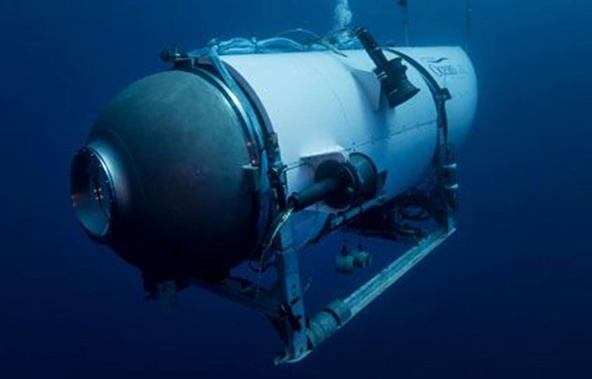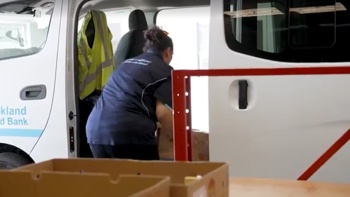
Talk to someone who rode on the Titan submersible, and they’re likely to mention a technological glitch: the propulsion system failed or communications with people on the surface cut out. Maybe there were problems balancing weights on board.
They are also likely to mention Stockton Rush, the OceanGate Expeditions CEO who died on the fatal trip this week. He has been described by past passengers as both a meticulous planner and an overconfident pioneer.
In the wake of the Titan’s fatal implosion near the Titanic shipwreck on Sunday, some people who embarked on the company’s deep-sea expeditions described experiences that foreshadowed the tragedy and look back on their decision to dive as “a bit naive.”
But others expressed confidence and said that they felt they were “in good hands” nearly 13,000 feet (3962 metres) below the ocean’s surface.
Watch: The moment crew realise thruster was installed backwards
‘Like playing Russian Roulette’
“I 100 per cent knew this was going to happen,” said Brian Weed, a camera operator for the Discovery Channel’s Expedition Unknown show, who has felt sick to his stomach since the sub’s disappearance.
Weed went on a Titan test dive in May 2021 in Washington state’s Puget Sound as it prepared for its first expeditions to the sunken Titanic. Weed and his colleagues were preparing to join OceanGate Expeditions to film the famous shipwreck later that summer.
They quickly encountered problems: The propulsion system stopped working. The computers failed to respond. Communications shut down.
Rush, the OceanGate CEO, tried rebooting and troubleshooting the vessel on its touch screens.
“You could tell that he was flustered and not really happy with the performance,” Weed said. “But he was trying to make light of it, trying to make excuses.”
Submersible pilot Randy Holt, right, and Stockton Rush, left, CEO and Co-Founder of OceanGate. Photo / AP
They were barely 100 feet (30 metres) deep in calm water, which begged the question: “How is this thing going to go to 12,500 feet — and do we want to be on board?” Weed said.
Following the aborted trip, the production company hired a consultant with the US Navy to vet the Titan.
He provided a mostly favourable report, but warned that there wasn’t enough research on the Titan’s carbon-fibre hull, Weed said. There also was an engineering concern that the hull would not maintain its effectiveness over the course of multiple dives.
Weed said Rush was a charismatic salesman who really believed in the submersible’s technology — and was willing to put his life on the line for it.
“It was looking more and more like we weren’t going to be the first guys down to film the Titanic — we were going to be maybe the 10th,” Weed said of the possible Titan expedition. “I felt like every time (the vessel) goes down, it’s going to get weaker and weaker. And that’s a little bit like playing Russian roulette.”
For work projects, Weed has swum with sharks, rappelled into remote caves and snowshoed through Siberia. But he and his colleagues pulled out of the dive to the Titanic.
“I didn’t have a good feeling about it,” he said. “It was a really hard choice to make.”
‘I always felt I was in good hands’
Mike Reiss, a writer for The Simpsons television show, said he had positive experiences on the dives he made with OceanGate, including to the Titanic wreck site.
“When my wife first came to me with this (idea), I said to her, ‘Well, this sounds like a fun way to get killed,’” Reiss said. “I knew (the risks) going in there. I always felt I was in good hands.”
Reiss said he went on three trips with OceanGate in waters near New York City — and that the company took safety seriously.
“Mostly it was just breathtaking how well it all went,” Reiss said of his 2022 dive to the Titanic. “It’s a 10-hour trip. And I went from sea level to two and a half miles down, and then back to sea level. And at no time did the pressure change in my ears. I didn’t get the same feeling I get in the New York elevator. To me that’s a remarkable achievement.”
Reiss said he was in a “different state of mind” on the expedition because he was so engaged.
/cloudfront-ap-southeast-2.images.arcpublishing.com/nzme/ACRIBGVEIRD65JGYTRURCVQ36M.jpg)
The US Coast Guard said on Thursday that the missing submersible Titan imploded near the Titanic shipwreck site, killing everyone on board. Photo / AP
“You’re never hungry. You’re never thirsty. They have a bathroom on board. It has never been used,” he said. “You just become a different kind of person. You even know you could die and it doesn’t bother you.”
Reiss said he did notice some issues with the Titan, although he wasn’t sure everything was a glitch.
For instance, the communications didn’t always work, like a cellphone losing service. The Titan’s compass also started “acting frantically” when they got to the ocean floor near the sunken Titanic.
“I don’t know if that’s an equipment failure or because magnetism is different two and a half miles down,” he said.
‘The fatal flaw is what he will be remembered for’
Arnie Weissmann, editor-in-chief of Travel Weekly, never rode in the Titan despite spending a week aboard its support ship in late May, waiting for the weather to clear. He briefly climbed into the submersible, but the dive was ultimately cancelled.
Wind, fog and waves were the stated reasons, but Weissmann wondered whether the submersible’s readiness was also a factor.
Over cigars one night, Rush told Weissmann that he got the carbon fibre for the Titan’s hull at a big discount because it was past its shelf-life for use aeroplanes, Weissmann said. But Rush reassured him it was safe.
“I really felt there were two Stockton Rushes,” Weissman said. “There was the one who was a good team leader and efficient and getting the work done. And there was this cocky, self-assured, others be damned, ‘I’m going to do it my way’ sort of guy. And that’s the one I saw when we went out the back of the boat and had our cigars.”
But he also was a strong leader, said Weissmann, who recalled Rush leading lengthy planning meetings and urging anyone who was interested to read a book called The Checklist Manifesto: How to Get Things Right that he left in the ship’s lounge. If a repair was complex, Weissmann said Rush would tell those assigned to it to pause for five minutes after completing it to make sure it was done correctly.
Looking back, Weissmann believes Rush had a fatal flaw: overconfidence in his engineering skills and the perception that he was a pioneer in an area that others weren’t because they were sticking to the rules.
“But in the end, for sure, the fatal flaw is what he will be remembered for — even though he was a three-dimensional human being like everybody else,” Weissmann said.
‘I was a bit naive’
Arthur Loibl, a retired businessman and adventurer from Germany, was among OceanGate’s first customers to dive to the sunken ocean liner.
“You have to be a little bit crazy to do this sort of thing,” he said.
His submersible mates included Rush, French diver and Titanic expert Paul-Henri Nargeolet and two passengers from England.
“Imagine a metal tube a few meters long with a sheet of metal for a floor. You can’t stand. You can’t kneel. Everyone is sitting close to or on top of each other,” Loibl said. “You can’t be claustrophobic.”
During the 2.5-hour descent and ascent, the lights were turned off to conserve energy, he said, with the only illumination coming from a fluorescent glow stick.
The dive was repeatedly delayed to fix a problem with the battery and the balancing weights. In total, the voyage took 10.5 hours.
He described Rush as a tinkerer who tried to make do with what was available to carry out the dives, but in hindsight, he said, “it was a bit dubious.”
“I was a bit naive, looking back now,” Loibl said.
Take your Radio, Podcasts and Music with you

/cloudfront-ap-southeast-2.images.arcpublishing.com/nzme/BRCZXHYWU5ARXNI6CNHASMNQOI.JPG)








